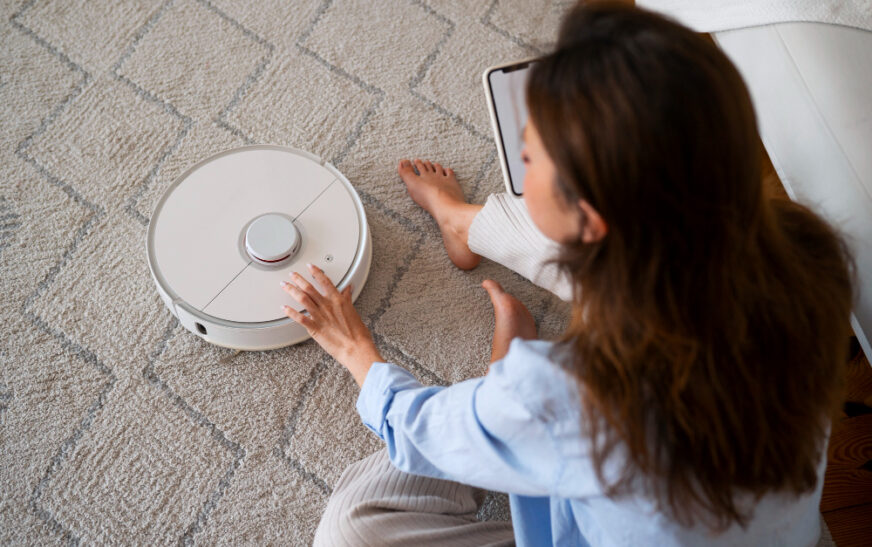Introduction
Have you ever found yourself imagining a life where your daily tasks could be managed with just the sound of your voice or a simple tap on your screen? Well, welcome to the reality of today! The advent of smart assistants is changing the game, turning these once-futuristic dreams into our everyday norms. From scheduling meetings to controlling home appliances, these clever little helpers are making our days more convenient and our routines more efficient. Delve into how these innovative technologies are revolutionizing the way we live, one voice command at a time.
Importance of Smart Assistants in Daily Routines
Imagine starting your day not with a frazzled search for your keys or a rushed calculation of your day’s schedule but with a warm greeting and a rundown of your day’s meetings, weather forecast, and traffic updates. This is not a scene from a sci-fi movie but the reality for many people today, thanks to smart assistants. These innovative tools are reshaping how we approach our daily routines, emphasizing convenience and efficiency, and automating tasks that previously required manual input, saving us time and often, a bit of sanity.
Convenience and Efficiency
The prime allure of smart assistants lies in their ability to make life easier. With voice commands or a few taps on a screen, we can manage calendars, set reminders, play music, or even order groceries. This hands-free convenience allows multitasking to become genuinely efficient, enabling users to do more with their time. Instead of getting bogged down with mundane tasks, users can focus on more productive activities or, better yet, spend that saved time relaxing and enjoying hobbies.
Automation of Tasks
Smart assistants go beyond mere convenience; they bring the power of automation into our homes and workplaces. They can learn our preferences, adapt to our routines, and even predict our needs before we articulate them. Picture a morning where your coffee begins brewing the moment your alarm goes off, or your thermostat adjusts automatically to your preferred temperature before you return home. This level of automation not only simplifies tasks but can also lead to energy savings and a more sustainable lifestyle.
Types of Smart Assistants Available
As smart technology evolves, so do the types of smart assistants that cater to various needs and preferences. Whether you’re looking for something to manage your smart home, help you stay on top of tasks, or provide companionship, there’s likely a smart assistant out there for you.
Voice-Activated Assistants
Voice-activated assistants are the most well-known type, thanks to popular devices like Amazon’s Alexa, Google Assistant, and Apple’s Siri. You can interact with these assistants using natural language, making them highly intuitive and accessible. They can play music, provide news updates, control smart home devices, and much more, all without requiring you to lift a finger.
Visual Recognition Assistants
Visual recognition assistants take things a step further by identifying objects and people using cameras. This technology can be particularly useful in security systems, where it can distinguish between known occupants of a house and strangers, or in accessibility tools, helping visually impaired users identify objects around them.
Task-Specific Assistants
For those looking for assistance in specific areas, task-specific assistants focus on particular functions. These can range from robotic vacuum cleaners that keep your floors spotless to smart garden assistants that help you take care of your plants by monitoring soil moisture and sunlight levels. The beauty of task-specific assistants is their ability to integrate seamlessly into specific aspects of your life, providing support exactly where you need it.
Smart assistants have undeniably found their place in the fabric of our daily routines, offering an unmatched level of convenience, efficiency, and a touch of futuristic living. As technology continues to advance, the potential for even more innovative and helpful assistants seems boundless, promising a future where our interactions with technology are seamlessly integrated into our lives.
Benefits of Using Smart Assistants
Smart assistants, from Siri and Google Assistant to Alexa and beyond, are transforming the way we manage our lives and tackle routine tasks. Their rapid evolution means they’re becoming increasingly integrated into our daily lives, offering myriad benefits that enhance convenience, efficiency, and even fun.
Time-Saving Features
One of the most immediate benefits of using smart assistants is their ability to save us precious time. By handling tasks that would otherwise require more manual effort, these digital helpers streamline our days in several ways:
– Voice Commands: Instead of typing, a simple voice command can set alarms, send texts, or call contacts.
– Scheduling and Reminders: They can manage your calendar, remind you of appointments, and even suggest the best times for meetings.
– Instant Information: Need a quick fact or figure? Your assistant can fetch it in seconds, saving you a deep dive on the internet.
These features liberate us from mundane tasks, freeing up time for more meaningful activities or simply a moment of relaxation.
Improved Productivity
Smart assistants are like having a personal secretary, one that’s available 24/7. They can increase our productivity by:
– Managing Tasks: From sending emails on your behalf to setting reminders for deadlines, assistants keep you on track.
– Information Retrieval: They improve workflow by quickly providing information or answering questions, reducing disruptions in your focus.
– Multi-Tasking: Assistants can perform multiple tasks concurrently, something we as humans find more challenging.
This level of efficiency means we can accomplish more in less time, with less stress.
Personalized Assistance
The magic of smart assistants lies in their ability to learn from your preferences and behaviors, offering personalized support that fits your life like a glove. This includes:
– Learning Preferences: Whether it’s your favorite music or the news sites you frequent, assistants adjust to serve you better.
– Proactive Suggestions: Based on your history, they can suggest tasks, entertainment, or even rest, before you think to ask.
– Voice Recognition: Many assistants can recognize different users, tailoring responses and services to each person’s preferences.
This level of personalization not only makes using these devices more enjoyable but profoundly impacts how effectively they can support our daily routines.
Integration of Smart Assistants in Different Areas of Life
The scope of smart assistants goes beyond mere novelty; they’re becoming integrated into virtually every aspect of our lives, making things easier, more efficient, and often more enjoyable.
Home Automation
Smart homes once felt like futuristic fantasies, but today, they’re a reality, largely thanks to smart assistants. They’ve become the central hub of home automation, controlling everything from lighting and temperature to security systems and entertainment. Life at home has never been more convenient or tailored to our preferences, all thanks to simple voice commands or app controls.
Work Environment
The modern workplace is another area benefitting greatly from the capabilities of smart assistants. They facilitate:
– Meeting Scheduling: Automating the tedious process of finding suitable times for all.
– Email Management: Prioritizing important messages and setting reminders for follow-ups.
– Enhanced Collaboration: Helping teams work together more efficiently, even from remote locations.
By carrying some of the administrative burden, smart assistants allow employees and entrepreneurs to focus more on their core tasks and innovation.
Health and Fitness
In the realm of health and fitness, smart assistants are making significant inroads. They can act as personal trainers, reminding you of workout times, suggesting exercise routines, or offering nutritional advice. Wearable devices with integrated assistants can track your progress, monitor your health stats in real time, and even alert you to potential health issues before they become serious. This proactive approach to health management is a game-changer, making it easier for individuals to achieve their fitness goals and maintain their overall well-being.
In conclusion, smart assistants are reshaping our routines in countless positive ways, fostering environments where convenience, efficiency, and personalized assistance aren’t just luxuries—they’re part of our everyday lives. Whether at home, work, or focusing on our health, these digital helpers are here to stay, continually evolving to meet our changing needs.
Challenges and Limitations of Smart Assistants
While smart assistants are undeniably transforming our daily lives with their convenience and efficiency, they aren’t without their challenges and limitations. From privacy concerns to reliability issues, users need to be aware of the potential downsides of integrating these devices into their routines.
Privacy Concerns
One of the most significant concerns with smart assistants is privacy. These devices are always listening, ready to respond to your command. However, this means they can inadvertently record private conversations, which raises concerns about how these recordings are stored and used. Companies assert that these recordings are essential for improving the device’s understanding and responses, but the fear of sensitive information being leaked or hacked is a palpable worry for many users.
Reliability Issues
Reliability is another challenge that users face with smart assistants. While technology has come a long way, smart assistants can still misunderstand commands or respond inaccurately. This can be frustrating, especially when relying on the device for important tasks like setting alarms, reminders, or even controlling smart home devices. The technology’s reliability is heavily dependent on the user’s internet connection quality and the assistant’s ability to process natural language, which isn’t always perfect.
Learning Curve
Lastly, the learning curve associated with smart assistants can be steep for some users. Each assistant comes with its set of commands and functionalities, which can be overwhelming, especially for those not as tech-savvy. Furthermore, maximising the potential of these devices often requires additional smart home gadgets, which not only adds to the cost but also to the complexity of setting up and managing an interconnected system.
Future Trends in Smart Assistants Technology
As we look to the future, the horizon is bright with potential advancements in the technology behind smart assistants. These developments promise to address current limitations and open up new possibilities for users.
Artificial Intelligence Advancements
The heart of smart assistant technology lies in AI, and advancements in this area are set to revolutionise how these devices understand and interact with us. Future smart assistants are expected to be more intuitive, understanding not just the words we say but the context and emotion behind them. This means they could offer more personalised responses and actions, making our interactions with them more natural and efficient.
Enhanced Interactivity
Alongside AI improvements, enhanced interactivity is on the rise. Future smart assistants will move beyond just voice commands and incorporate visual elements and gestures, offering a more immersive and interactive experience. Imagine a smart assistant that not only hears your request but can also recognize who in the household is speaking and tailor its responses accordingly.
Integration with Internet of Things (IoT)
Lastly, the integration with the Internet of Things (IoT) is an exciting trend that promises to make smart assistants even more integral to our daily lives. By seamlessly connecting with a broader range of devices and services – from our cars to our office equipment – smart assistants will be able to offer unprecedented levels of convenience and automation. Whether it’s preheating your oven on your way home from work or adjusting your home’s heating before you wake up, the possibilities are endless.
In conclusion, while there are challenges and limitations to the current generation of smart assistants, the future holds incredible promise. Through advancements in AI, enhanced interactivity, and deeper integration with IoT, smart assistants are set to become even more indispensable parts of our daily routines.
Conclusion
As we’ve explored, smart assistants are revolutionizing the way we manage our day-to-day life, weaving convenience and automation into the very fabric of our routines. From setting reminders to controlling smart home devices, these intelligent helpers are making life more efficient and enjoyable. They not only save us time but also help manage our tasks more effectively. In essence, smart assistants are not just a luxury; they are becoming a necessity for a modern, efficient lifestyle. By embracing this technology, we can make our daily routines less about managing tasks and more about enjoying life to the fullest. So, if you haven’t already, maybe it’s time to let a smart assistant into your life and see how it can transform your daily routine for the better.





















